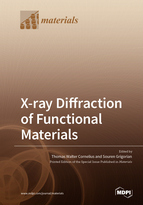X-ray Diffraction of Functional Materials
A special issue of Materials (ISSN 1996-1944). This special issue belongs to the section "Advanced Materials Characterization".
Deadline for manuscript submissions: closed (30 April 2021) | Viewed by 33735
Special Issue Editors
Interests: materials science; nanotechnology; synchrotron X-ray diffraction (coherent X-ray diffraction, laue microdiffraction); in situ nanomechanical testing; finite size effects; nanowires
Interests: material characterization; nanomaterials; nanoparticles; OFETs and solar cells; thin films and nanotechnology; local scale probing; in situ X-ray diffraction; real-time structural characterization
Special Issue Information
Dear colleagues,
With new functional materials being developed and their properties being strongly related to their microstructure, the characterization of the latter is of paramount interest. Thanks to its non-invasive character, adaptability to various environments, high sensitivity to crystalline structure and deformation as well as to defects, X-ray diffraction is the ideal tool to investigate the microstructure of these new materials.
The last 15 years have seen a continuous development of X-ray sources, optics, and detectors ,making X-ray microscopy of strain and defects a reality with realistic time scales. Thanks to the penetrating power of X-rays, in situ or even operando monitoring of the crystalline structure of materials and devices as a function of mechanical stimuli, temperature, gases, electric fields, etc. is being commonly performed. Such studies are invaluable to investigate physical mechanisms at work in real or close to real conditions. This is the case of elastic and plastic properties, catalytic activity, ferroelectric domain structure, and many others.
Moreover, advances in detectors and computer hardware and software facilitate time-resolved X-ray diffraction studies of the transient behavior of the microstructure, phase transitions, and physical changes caused by external stimuli. The time range covers more than ten orders of magnitude—from sub-picoseconds to kiloseconds. The advent of free electron lasers opens the few femtoseconds range enabling the study of electronic processes.
This issue is dedicated to the latest advances in X-ray diffraction using both synchrotron radiation as well as laboratory sources for evaluating the mixcrostructure and structure-to-property relation in functional materials (functional oxides, organic and hybrid materials for energy, electronics, etc.). Particular focus will be placed on novel in situ or operando approaches. Contributions addressing various materials from macroobjects to nanostructures by different techniques (powder diffraction, surface diffraction, coherent X-ray diffraction, Laue diffraction, etc.) as well as various length and time scales are welcome.
Dr. Thomas Walter Cornelius
Dr. Souren Grigorian
Guest Editors
Manuscript Submission Information
Manuscripts should be submitted online at www.mdpi.com by registering and logging in to this website. Once you are registered, click here to go to the submission form. Manuscripts can be submitted until the deadline. All submissions that pass pre-check are peer-reviewed. Accepted papers will be published continuously in the journal (as soon as accepted) and will be listed together on the special issue website. Research articles, review articles as well as short communications are invited. For planned papers, a title and short abstract (about 100 words) can be sent to the Editorial Office for announcement on this website.
Submitted manuscripts should not have been published previously, nor be under consideration for publication elsewhere (except conference proceedings papers). All manuscripts are thoroughly refereed through a single-blind peer-review process. A guide for authors and other relevant information for submission of manuscripts is available on the Instructions for Authors page. Materials is an international peer-reviewed open access semimonthly journal published by MDPI.
Please visit the Instructions for Authors page before submitting a manuscript. The Article Processing Charge (APC) for publication in this open access journal is 2600 CHF (Swiss Francs). Submitted papers should be well formatted and use good English. Authors may use MDPI's English editing service prior to publication or during author revisions.
Keywords
- X-ray diffraction
- powder diffraction
- surface X-ray diffraction
- time-resolved X-ray diffraction
- in situ/operando characterizations
- structure-to-property correlation
- synchrotron
- energy and functional materials
- functional oxides
- nanostructures








